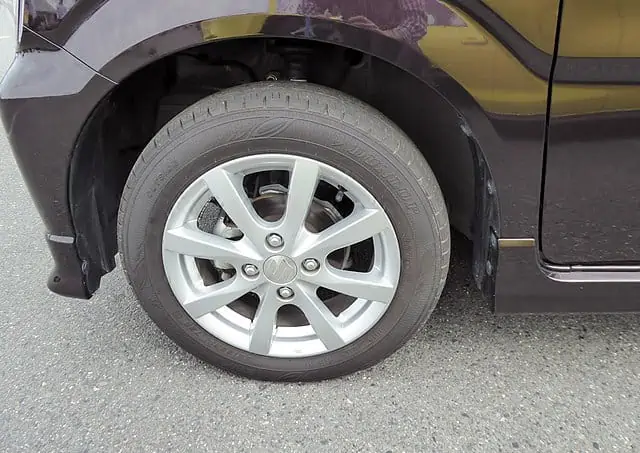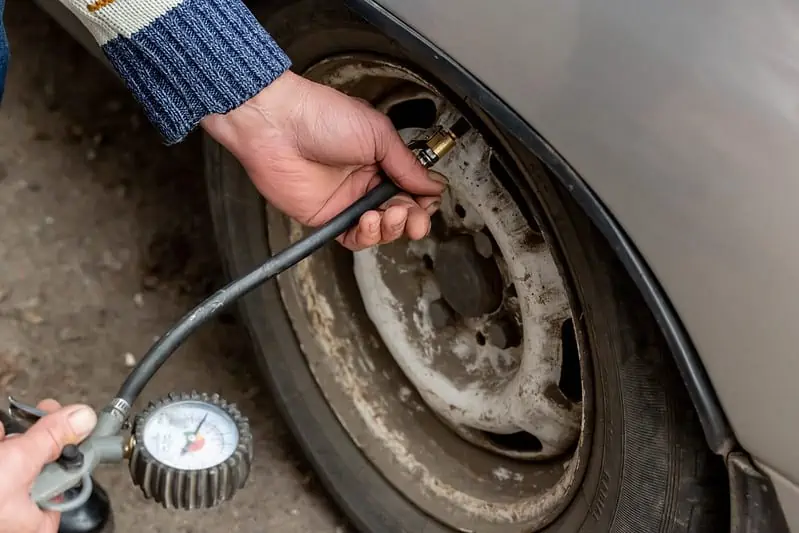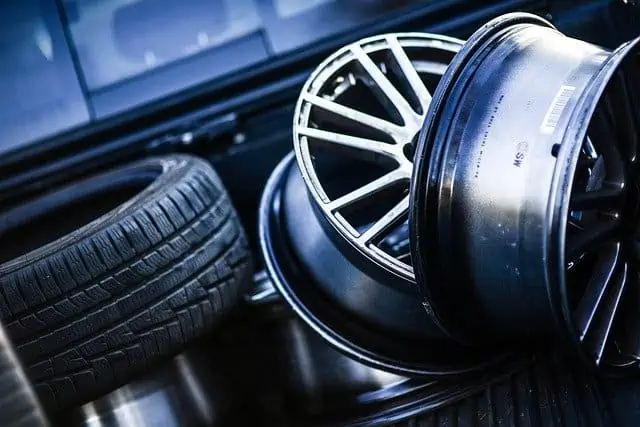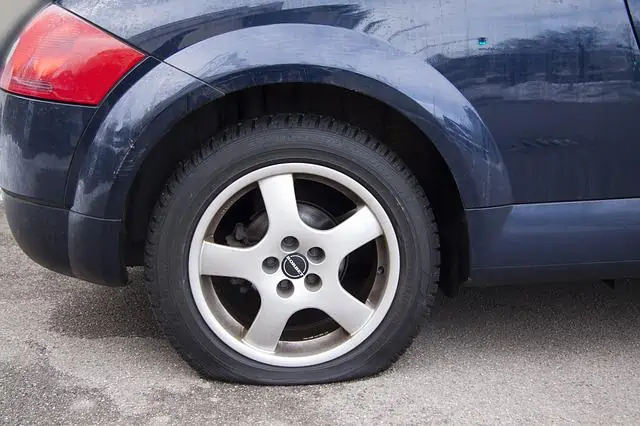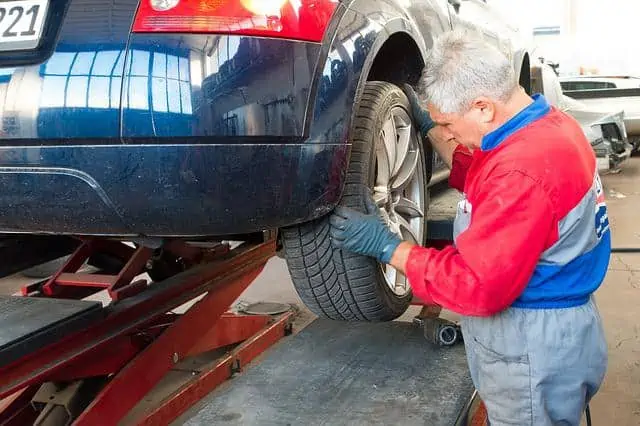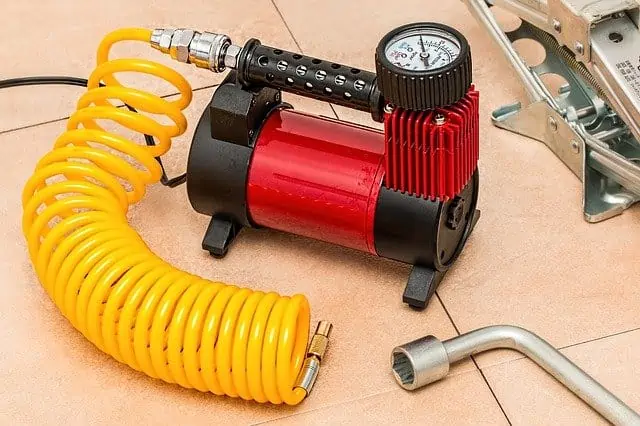Your car body interacts with the road through car tires only. That means keeping your car tires in good condition is a matter of safety.
It doesn’t matter whether you are a car enthusiast or not. Even if you are an archetypal car owner and want to enjoy the optimal performance of your vehicle, you need to maintain your car tires in proper condition.
Car Tire in Proper Condition on Road
Of course, the life of tires reduces significantly over time when you run them on the road. No doubt about it. But if you maintain the right tire pressure, it will increase the lifespan of your car tires. Plus you would also get the best performance out of your car.
So, what is the right tire pressure for your car and how frequently should you check it? And what is the optimum tire pressure in different weather conditions? Are over-inflated tires better or under-inflated?
All the answers to your questions will be given here in this blog. We will clear all your doubts.
But before you learn how to determine the right tire pressure for your car, it’s crucial for you to know what is the best timing and condition for checking tire pressure.
Why Timing is Important in Checking Tire Pressure
Both car and tire manufacturers recommend checking tire pressure when tires are neither hot nor cold.
What happens is that when you drive your car, the tires roll along the road and that friction generates heat that increases the tire pressure.
So, if you check your car tire pressure when they are hot, most likely you’ll see higher tire pressure than what your tires have.
That means those numbers would mislead you. So, let the hot tires cool off a bit, and then check tire pressure.
But How Will You Know Your Tire Pressure is Not Appropriate
Many people can’t even discern that their car tire pressure is amiss. They keep rolling their tires day and night in the same condition. I was guilty of that too.
Low Tire Pressure by Tokumei Gakari Naoshima / CC By 4.0
But over the years, I have learned to recognize the signs of having inaccurate tire pressure.
Here I’m sharing those six signs with you:
- You feel a little sluggishness in your steering wheel
- Your gas mileage has dropped significantly
- Your car slightly dips than usual when you sit in it
- Your car doesn’t give you a quick response when you hit the gas
- You feel a slight heaviness in your car while driving
- You may feel more bumps while driving if car tires are overinflated
If you notice all or any one of these signs, check your car tire pressure first before considering taking your car to a mechanic. You might save some bucks.
But don’t always wait for the signs to appear. It would be best for your car if you check tire pressure regularly.
How Often Should You Check Tire Pressure
Before you fill in any air in your tires or extract it from them, you need to ascertain the current tire pressure.
In general, people rely on the TPMS (Tire Pressure Monitoring System) of their cars to check and maintain tire pressure.
When TPMS indicates tire pressure is low, then they fill the air in the tires. But what if your car tires are overinflated? In that case, TPMS won’t be helpful to you because it doesn’t give any indication of overinflated tires.
It only gives signals of underinflated tires when tire pressure falls below the lowest point where it might be dangerous for you to drive your car.
The reason is that TPMS isn’t capable enough to detect gradual air loss. Plus your car has four tires and not all TPMS shows which tire has low air pressure. In the end, you have to find it by yourself.
What if TPMS itself isn’t working correctly and fails to transmit signals to the dashboard? This situation can be menacing for you.
It’s good to have useful technology on your side, but you can’t completely rely on them.
So, it’s advisable to check your car tire pressure after every 30 days if you don’t drive your car frequently.
Inflating Tire by Marco Verch Professional / CC By 2.0
But if every other day you take your car for long trips, then check tire pressure after every seven days.
In addition to that, weather conditions also cause changes in tire pressure. A general rule of thumb is that car tire pressure of passenger vehicles drops by one psi every time when weather conditions fluctuate by 10°F (5.6 °C).
That is to say, if temperature fluctuates unexpectedly by 20 to 30 degrees, your car tire pressure will drop by 2 to 3 psi within 24 hours.
And tire pressure of heavy commercial vehicles drops even further whenever there is a slight change in weather conditions.
And if your vehicle is loaded and tires are underinflated, you can lose control of your vehicle and even your tire can burst.
So, if you’re a commercial vehicle driver, then you need to check your commercial vehicle’s tire pressure more frequently than you will do for your passenger car.
So, whenever the season changes or you notice a drastic change in weather, just understand that it’s time for you to monitor tire pressure.
You can take your vehicle to any auto part store or to any gas station for checking tire pressure. Even mechanics can help you do that. But all these ways will cost you time and sometimes money.
If your car has TPMS, it will give you a tire pressure signal every time it drops down. But as you already know, TPMS doesn’t indicate a low tire pressure sign unless your tires lose 25% of their air. That is how this technology works and it is still useful.
Let’s take a deeper look at how these tire monitoring systems work.
How Tire Pressure Monitoring System Works in Your Car
TPMS uses a sensor that automatically and constantly measures tire pressure. That sensor is positioned between the wheel and tire where pressure forms and is connected to your car’s onboard computer.
When the tire pressure falls below a certain point, the sensor recognizes it and displays a warning sign on your car’s dashboard.
Generally, tire pressure monitoring systems are integrated into cars by either using direct or indirect methods.
What are these methods? Let’s understand.
How Direct Tire Pressure Monitoring Method Differs from Indirect Tire Pressure Monitoring Method
In a direct tire pressure monitoring system, the car’s onboard computer receives pressure readings from a sensor that is fixed on the wheel rim.
But indirect tire pressure monitoring system relies on your car’s ABS wheel speed sensor.
It observes the number of revolutions wheels are taking to turn. The wheel that has the lowest air pressure among the other three will take more revolutions. That’s how it discerns which car tire requires to be inflated.
But there is a huge problem with the indirect tire pressure monitoring system. If all the tires lose air at the same time, they will revolve at the same speed. In that case, the indirect tire pressure monitoring system can’t identify the low tire pressure and won’t show you any signal.
Plus it can malfunction also and show you the wrong readings. You might get a signal that your tire pressure is inaccurate even when everything is right.
This sometimes disturbs your peace of mind while driving. But this is the case with every technology. You need to replace it in the fullness of time.
The most suitable time for you to replace the old sensor with a new one is when you mount a new tire on your rim. Then you won’t have to pay extra charges for removing a tire.
The sensor will cost you around $50. The price may vary depending on your vehicle. But it’s better to keep TPMS working accurately. Otherwise, you would be running your car with low tire pressure cluelessly.
And if you do that, will that damage your car? Let’s find out.
What Happens When You Drive a Car with Low Tire Pressure
The same thing when you drive a car on an icy road. What happens then? It slips and it happens due to poor traction. Right?
You can lose traction and slip on a normal road also if your tires are underinflated. It proliferates the risk of accidents. Your tire will wear out in a flash. They can even burst if you keep driving your vehicle with low psi.
So, should you stop driving your vehicle immediately when you find out your tire pressure is low?
No, it’s not feasible. But it all depends on how much air pressure you have at that point in time in your tires. If you are short of only 3 to 4 psi, you can drive like that for a week or two.
But if your tire pressure is around 20 psi, then you should consider it an emergency situation and fill the air in your tires as soon as possible.
Flat tire
Checking tire pressure isn’t a daunting task. You can easily do it by yourself at home.
How?
That we’ll guide you here.
How to Check Tire Pressure by Yourself
Going to an auto parts store just to check tire pressure seems like a hassle. So you put it off.
Checking Tire Pressure
It might seem like a trivial matter to you, but it is important. According to NHTSA (National Highway Traffic Safety Administration), when you drive a vehicle with underinflated tires, your risk of losing car control and getting involved in a car crash increases by 300%.
It’s important to learn the skill of monitoring tire pressure so you can do it by yourself at home.
All you need is a Tire Pressure Gauge. It’s a tire pressure measuring tool which you can either get an analog or digital one according to your preference.
Tire Pressure Gauge by Lucy Zou / CC By 2.0
Generally, you will find three types of portable tire pressure gauges in the market:
- Stick pressure gauge
- Dial pressure gauge
- Digital pressure gauge
The only major difference apart from their appearances among these three pressure gauges is the way they display readings.
Like, a stick pressure gauge is a long thin rod that displays numbers on its top end of the sleeve. But the dial pressure gauge shows pressure readings through its dial and you read It like you read a watch.
The digital pressure gauge is quite convenient as it displays numbers on its screen.
You can choose any of them. All these three gauges are easy to operate and have similar operational methods.
You connect its one end to the valve stem on the tire and the other end has a gauge that shows tire pressure readings.
It takes only a minute or two to check tire pressure by yourself. Here are three simple steps to do that:
- First of all, unscrew the valve cap from the valve stem. Don’t worry, it won’t release the air. It’s just a valve cap placed on the valve stem to protect it from dirt and damage. So, remove and keep it safe somewhere.
- Take your tire pressure gauge tool and position its pipe-like end firmly on the valve stem. Press it gently and you’ll hear the sound of air escaping the tire. Hold it like this for a few seconds and note down the tire pressure measurements that display on the gauge.
- Now after measuring the tire pressure of all four tires, you need to either fill or release some air to maintain the right tire pressure before placing the valve cap back in its position.
But what if you don’t have a tire pressure gauge at your disposal. Is there any way you can find out that tire pressure is low?
Of course, you can find out. Maybe not that accurate, but you can.
Checking Tire Pressure Without a Gauge
Inspecting car tire in garage
Above we have talked about how your car gives signals regarding inaccurate tire pressure. However, it’s difficult for new drivers, sometimes even for experienced drivers, to recognize those signs.
Especially, if your car doesn’t have a TPMS and you have forgotten to carry your tire pressure gauge, in that case, you can apply these methods to check whether you need to inflate your tire or not.
1. Use Your Hands
Place your both hands on the tire and press it hard with your palm. Feel if the tires remain firm or compress slightly. If the tires feel soft, you need to inflate them.
2. Watch Tires Carefully
Step out of your vehicle and circle around it. Observe the shape of each tire. If you notice any flattening in any of the tires, add some air to it.
3. Load Your Car
Fully loaded car
In general, you need to fill more air if you are loading your car to its full capacity. You can find out if you need to add more air or not. After you load the car fully, check the tires. If tires sink more than usual, add some more air to them.
4. Feel Your Car
If you feel more jolts or the steering wheel feels stiffer than usual while driving the car, you might have some issue with tire pressure.
You can resolve it easily by filling the air in tires by yourself.
Maintain Tire Pressure by Yourself at Home
Now you know your current tire pressure. It’s time to fill the air in underinflated tires.
You can go to any gas station and use their air machine for free. It’s easy. But we recommend you to have your own portable car tire inflator so you can fill the air in your car tire by yourself.
Whether you are at home or at some far-flung location where neither you find a gas station nor any mechanic store nearby, but you need to fill the air in your car tires immediately, in such situations, having a portable car tire inflator is very handy.
Another benefit of owning a portable car tire inflator is precision.
Portable Car Tire Inflator
Whereas air machines at gas stations are usually old, overused, and clapped-out. When you inflate tires by using these old machines, the whole idea of checking and filling the air in your car tires fails because you couldn’t fill the right air pressure in your tire.
And you already know the backwash of driving a car with inexact tire pressure. So instead of buying all those troubles, buy one portable car tire inflator.
They are easy to operate. You can fill air effortlessly with a press of a button, or you can get a foot pump if you prefer to fill air manually.
When you have your tire inflator, you can fill or release the air at any time depending on your need and situation.
If you are carrying heavy luggage or your vehicle is full, fill 2-3 points of extra air and subsequently release it after you reduce the load.
This will help you maintain the recommended tire pressure at all times and you can get the best out of your car tires.
But what is the recommended air pressure for your car tires and how to find that?
Ways to Find the Right Tire Pressure for Your Car
Your car tire will remain in a good condition for an extended period of time and the mileage of your car will also improve. That means you can save some money also if you maintain the right tire pressure.
So, just fill your car tires with the pressure that your car manufacturer recommends. You can find their recommendation written on the vehicle’s door.
If you open your car’s driver-side door, depending on your car type, you will see a sticker at the bottom or at the side of the door. The correct tire pressure for your car is written on that sticker.
Car Tire Pressure Sticker on Car Door by Bindydad123 / CC by 4.0
You can also look into the owner’s manual to check the recommended tire pressure for your car.
Manufacturers typically recommend 32 psi to 35 psi for most passenger car tires. PSI is a tire pressure measuring unit and it stands for pounds per square inch.
So, Should You Always Inflate All Four Tires with The Same Tire Pressure?
Not all four tires have the same tire pressure. Plus road condition and the load you’re carrying in your vehicle also determine whether you need to increase the tire pressure or decrease it.
If the road condition is bad, it’s better to slightly reduce the air pressure for better handling. But as long as you inflate your car tires according to your car manufacturer’s recommendation, you should be good to go.
In general, tires that carry the most load of the engine have higher tire pressure. That’s why the front tires of the front-wheel-drive car have higher PSI than the rear tires.
If you look closely at your car tires, you’ll see some numbers written on them. Don’t consider that number as ideal tire pressure. It indicates the max PSI level for that particular tire.
Honestly, a slight difference in tire pressure is not a matter of concern to most people unless you’re a professional driver. But it’s better to monitor tire pressure after every week or before you go for a long trip.
Strictly don’t let your car tire pressure fall below 20 psi. It can be devastating for car tires and you as well.
Importantly, all you need to remember is that if your car is small, maintain 32 to 35 psi tire pressure. 40 psi is good for sports cars or medium-sized passenger cars. But for heavy commercial vehicles, it is too low.
So, follow your car’s owner’s manual and inflate each tire with the optimal PSI that they recommend. Discard everything else.
And maintain the optimal tire pressure in your spare too. Even if you have replaced your old tires with the new ones of the same size, you should always follow the tire pressure instructions written on the label on the driver-side door.
According to a Michelin study, if your tire pressure drops by 14.5 psi, your car will consume 3-5% more gas.
So, it will be in your favor if you weekly check your car tire pressure and fill the air as per the manufacturer’s guidelines.
Checking Tire Pressure with Tire Pressure Gauge by Nan Palmero / CC By 2.0
Filling the Air in Tires by State Farm / CC By 2.0

Jim Wicks is the founder of MotorVehicleHQ. With over two decades of experience in the automotive industry and a degree in Automotive Technology, Jim is a certified car expert who has worked in various roles ranging from a mechanic, car dealership manager, to a racing car driver. He has owned more than 20 cars over the past 15 years. Ask him about any vehicle you see on the road and he can tell you the make, model and year. He loves the aesthetics of all things cars, and keeps his vehicles in pristine condition.
In his free time, Jim enjoys getting his hands dirty under the hood of a classic car or taking long drives along the country roads. His favorite car? A 1967 Shelby GT500, a true classic that, according to Jim, “represents the pure essence of American muscle.”

